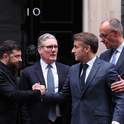“FURY AT BIAS ON BBC TV DEBATE,” said the Daily Mail headline. True, last night’s audience did seem ready to cheer on the smaller parties while jeering at Amber Rudd—who was filling in for Theresa May—when she asked that the Tories be judged on their record. But was the debate audience really biased?
According to a methodology note issued by ComRes, who handled recruitment for the BBC TV Debate, every attempt was made to “recruit a representative sample.”
“The recruitment process,” their note says, “was stringent, securing a balanced audience using recognised, high quality and best-practice recruitment techniques.”
Every participant was screened, with demographic questions used to balance age, gender, ethnicity, socio-economic status and employment status. Adults who had “campaigned politically at any election from 2014 onwards” were also filtered out.
ComRes then divided up the audience into 20 per cent Labour voters, 20 per cent Conservative, and 10 per cent each of the Liberal Democrats, SNP and UKIP, as well as 5 per cent from the Greens and Plaid Cymru.Trust me - we did the recruit and the sweat and tears i put into those quotas shows otherwise! — Dan Holden (@DanSHolden) May 31, 2017
This breakdown was designed to reflect both the result of the 2015 General Election and “current voting intention trends.”
The sharp-eyed will have spotted that doesn’t add up to 100 per cent—that’s because ComRes also brought in “undecided” voters, who were wavering from their previous voting preference. They also split the audience as close to 50-50 as possible in regards to their votes from the 2016 EU referendum.
And to make sure, audience members were contacted by telephone and rescreened on key questions to make sure that their answers matched up.
So does that add up to a biased audience? Well, no. Does it add up to a left-wing one? Arguably.
If we identify Labour, the Liberal Democrats and the Greens as left-wing parties, their audience representation already surpasses that of the Conservatives and UKIP—before we think about the SNP and Plaid Cymru. As ComRes Chairman Andrew Hawkins puts it,“Despite howls of protest about audience bias, what people often fail to realise is that when you have a panel on which five out of seven people represent left wing parties, those five will inevitably get more applause than the minority participants.”
Add in the possibility that there were simply some more vocal characters among the audience’s more left-wing portions, and what comes out of your TV may well have sounded biased—while, in fact, being nothing of the sort.
Or, to use Hawkins' phrase, “The clapometer is a wholly flawed way of judging the partiality of an audience.”












